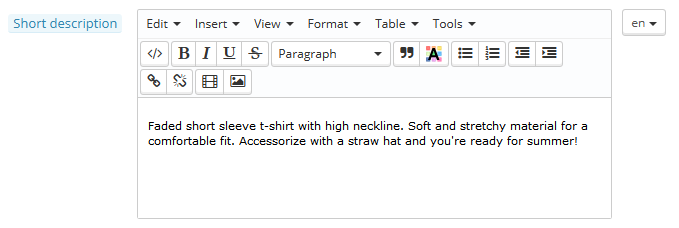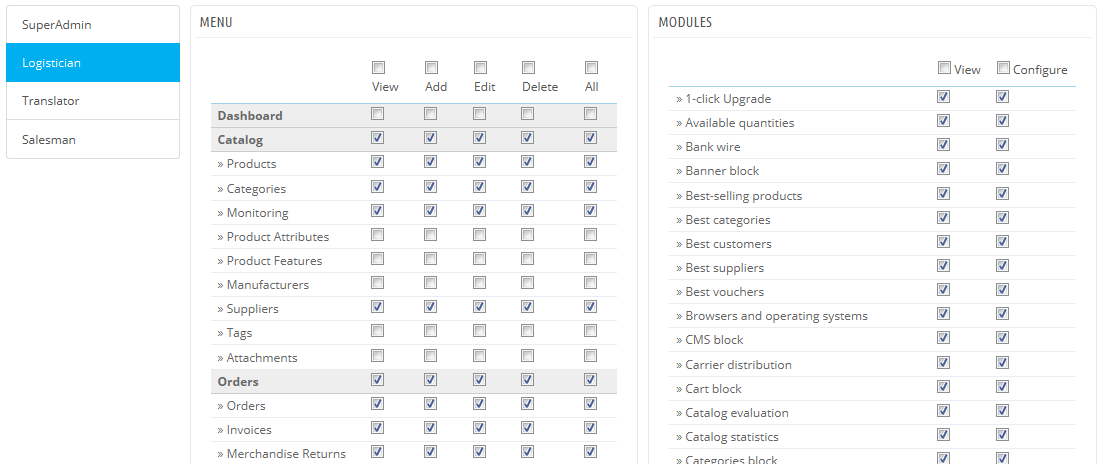...
Deactivating your shop means making sure that no one can access it while you are busy making changes, creating products, settings prices and taxes, installing payment modules and a new theme, setting carriers... This is called "putting your shop in maintenance mode".
In your back - office, go the "Preferences / Maintenance" page. This page features two simple settings:
- Enable Shop. Simply set it to "No", and your front-end will display the maintenance page to your visitors, which simply states that your shop will soon be back online.
- Maintenance IP. This is where you must put your own IP address, so that you can still get access to your front page, and browse your shop as if it was available to all. This is a must-do every time you put your shop in maintenance mode, as you will always need to browse your front-end so as to make sure everything is in place as intended.
Simply click on the "Add my IP" button. You can add more IP addresses by separating them with commas.
| Tip |
|---|
If you are have already decided on what your theme and products are, you can simply put your shop in Catalog mode. This means that customers can browse your shop, but no price will be displayed, and they won't be able to add anything to their cart until you disable the Catalog mode. You can activate the Catalog mode by going to the "Preferences / Products" page, where it is the first option. |
Delete the content of the default shop
The default installation features a handful of products – mainly Apple products, along with a couple of third-party accessorieswomen's clothing. Their only use is to help you explore the organization of a real store. After you've learned the intricacies of the ties between products, categories, orders and customers, you should delete all these items in order to start your shop with a clean slate.
You must therefore delete all the default data, which means:
- products and their...
- categories
- attributes
- features
- manufacturers
- suppliers
- image mappings
- tags
- orders
- order messages
- customers
- customers shopping carts
- carriers
- price ranges
- weight ranges
- contact & stores (delete or adapt to your business' needs)
- CMS pages (delete or adapt to your business' needs)
This would means mean browsing through the many various screens of the back - office and deleting content one page after the other, but there is much easier way:
- Go to the "Modules > Modules" page,.
- Find the "PrestaShop Database Cleaner" module and click its "Install" button,.
- You are directly taken to its configuration page (if not, click its "Configuration" button),.
- Click the Read and accept the warning, then click the "Delete Catalog" button: it will delete all your products and their attributes, manufacturers, etc.
- Click the Read and accept the warning, then click the "Delete Orders & Customers" button: it will delete all your orders and your customers.Finally, click customers and their orders, carts, etc.
- Click the "Check & fix" button to refine your database integrity constraints.
- Click the "Clean & optimize" button to reorganizes the physical storage of table data and associated index data, to reduce storage space and improve I/O efficiency when accessing the tables.
THERE IS NO WAY BACK. Be sure to only click these buttons only if you do intend to wipe your database from its default content.
| Tip | ||
|---|---|---|
| ||
The iPod Touch from the default installation is tied to the sample order (made by sample customer John Doe), and thus cannot be deleted until the order is deleted. Therefore, in order to delete this product, you first need to delete this sample order. To safely delete the default order (and thus be able to delete the iPod from your catalog), install the "PrestaShop cleaner" module (see above), open its configuration screen and check the "Delete Orders & Customers" button. |
Configure your shop's information
...
You should pay attention to the following settings, most of which are important because they are displayed on the front -officeoffice, and therefore in plain sight of your customers.
| Tip |
|---|
Some of these settings require you to configure a module instead of changing one of PrestaShop's preferences. Configuring a module is easy:
For each module presented here, you should read their documentation for more information. |
Setting | Description | Where to find it |
|---|---|---|
Shop name | Defines your brand, most notably on search engines (Google, Yahoo!, Bing...). | "Preferences" menu, "Store Contacts" page, then in the "Contact details" section, edit the "Shop name" option. |
Shop logo | Defines your brand visually. The default logo says "YourLogoHereYourLogo" as an incentive to use yours. | "Preferences" menu, "Themes" page, "Appearance" section, then change the various default images to your logo. |
Default shop currency | The currency in which you want to set the default price for your products. | "Localization" menu, "Localization" page, "Configuration" section. |
Customer service info | A block presenting the phone number for your customer service, and a button to send you an e-mail. | "Contact block" module. |
Company info / | A block presenting your contact address, the phone number for your customer service, and a link to send you an e-mail. | "Block contact infosinfo" module. |
Advertising | A block presenting an image with a link to another site. | "Block advertisingAdvertising block" module. |
Image slider | The slider presents several images, scrolling one after the other. It is a strong visual signature for your store and products. | "Image slider for your homepage" module. |
CMS pages | The content of static pages, such as "About Us", "Delivery", "Legal Notice", "Terms and Conditions", and "Secure Payment". Some of them have default content, which you should adapt to your business; some others are empty, and you should paste your own text. | "Preferences" menu, "CMS" page, then edit and create pages at will. |
| Social networks | A block presenting three links: your company's Facebook page, your company's Twitter account, and the RSS feed for your company's blog (or "current events" site). | "Social networking block" module. |
| Top menu | The top of the default theme uses a top menu to indicate categories that the visitor can go to, as well as links to other locations – for instance, the default installation has a "Blog" link which sends the use to the official PrestaShop blog. | "Top horizontal menu" module. |
| Homepage content | The default theme contains a lot of demo content: texts, images, links, etc. If you intend on using that theme for your own store instead of buying your theme, you should make sure to remove all the default content first. | "Theme configurator" module: this module handles a lot of things on your theme. Mainly, it enables you to switch some feature off and on (social sharing buttons, top banner, payment logos, etc.), and perhaps more importantly, it lets you easily add/change images on your home-page. "Custom CMS information block" module: this module helps you manager the two last blocks at the bottom of the home-page, right before the footer: the "Free shipping etc." one and the "Custom block" one. |
These are the most visible default settings on your front-end – at least with the default theme.
The "Where to find it" column enables you to see where you can find the interface to change these aspects of your store. This user guide will provide you with more details for each interface.
...
PrestaShop is able to work with many languages, both on the front - office and the back - office. Each back-office As soon as more than one language is enabled in your back office, each back office text-field is accompanied with a flag iconlanguage code selector, which indicates the current language, and which you can click in order to choose another language in which to write that field's content.
By default, PrestaShop is installed with two languages: the one used when installing the software, and French. To manage the currently installed languages, go to the "Localization / Languages" page. It presents you with a table of the available languages.
The currently enabled language(s) have a green "Yes", while the others have a red "No". Click on a "Yes" to disable the selected language; click on a "No" to enable it back.
| Info |
|---|
You can install and enable many languages if you think your shop needs them, but be aware that you will have to translate your content for all of the enabled languages: product names, descriptions, tags, category names and descriptions, static content (CMS pages), module settings, etc. |
You can easily import many more languages in the "Localization / Localization" page, and then enable them in the "Localization / Languages" page.
...
Should you have people helping you with your shop (whether they are your family, your friends, or paid employees), you should make sure to create an employee account for each of them – if only to know who has performed which recent action. The other advantage is that you can give them specific profiles and specific access rights to the administration pages: for instance, you might not want everyone to have access to your statistics, your invoices or your payment settings.
You can create as many profiles as needed.
...
Now that you have a proper account for this employee, you should give that account specific permissions, tailored to the employee's tasks. By default, a new profile cannot do much. It is up to you to set exactly the parts of your shop to which that profile should have access. It can be a tedious task, but it is an important one.
To assign permissions to an employee account, you must use the "Profile" option in the account creation page: this menu lets you pick the account's profile (SuperAdmin, translator, etc.)
You can edit these permissions this way: go to the "Administration" menu, select "Permissions", and select the profile you want to change. A long list of permissions appears: edit them at will. Your changes are saved automatically.
...
Your shop is meant to earn money, and this can only become a reality if you use at least one payment module. Several modules are already available in the default install, which you can install and configure (from the "Modules" page under the "ModuleModules" menu, in the "Payments & Gateways" category), and create restrictions for them (in the "Payments & GatewaysPayment" page under the "Modules" menu). Many payment modules require you to first set up an account on the service they were built for.
...
| Info |
|---|
Check and bank wire are the only two payment methods which are enabled by default. If you choose to keep them, you need to configure them with your information: check order and address, account owner, bank details (IBAN, BIC, etc.). These payment methods are configured through the "Bank Wire" and "CheckPayment by check" modules, which you can find in the "Payments & Gateways" category of the modules list. |
...
You can also choose to create your own theme, or have it created for you by a developer. Refer to the online PrestaShop Designer Guide for help.
Once your theme is installed, you should explore it fully in order to know it by heart and be able to help customers out of a situation. Read its documentation carefully.
...
PrestaShop comes bundled with more than a hundred modules. These are very varied: analytics, front - office features, payment, shipping... You should explore the available modules in full, in order to know which ones you might want to enable, and which you'd rather keep disabled.
...




